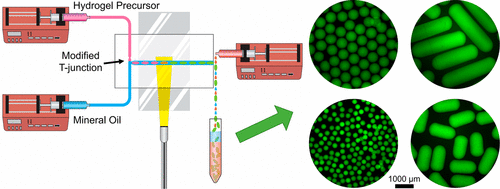当前位置:
X-MOL 学术
›
ACS Biomater. Sci. Eng.
›
论文详情
Our official English website, www.x-mol.net, welcomes your
feedback! (Note: you will need to create a separate account there.)
Microfluidic Production of Cell-Laden Microspheroidal Hydrogels with Different Geometric Shapes
ACS Biomaterials Science & Engineering ( IF 5.4 ) Pub Date : 2020-09-15 , DOI: 10.1021/acsbiomaterials.0c00980 Yuan Tian 1 , Elizabeth A. Lipke 1
ACS Biomaterials Science & Engineering ( IF 5.4 ) Pub Date : 2020-09-15 , DOI: 10.1021/acsbiomaterials.0c00980 Yuan Tian 1 , Elizabeth A. Lipke 1
Affiliation

|
Providing control over the geometric shape of cell-laden hydrogel microspheroids, such as diameter and axial ratio, is critical for their use in biomedical applications. Building on our previous work establishing a microfluidic platform for production of large cell-laden microspheres, here we establish the ability to produce microspheroids with varying axial ratio (microrods) and elucidate the mechanisms controlling microspheroidal geometry. Microspheroids with radial diameters ranging from 300 to over 1000 μm and axial ratios from 1.3 to 3.6 were produced. Although for microfluidic devices with small channel sizes (typically <500 μm) the mechanisms governing geometric control have been investigated, these relationships were not directly translatable to production of larger microspheroids (radial diameter 102 – 103 μm) in microfluidic devices with larger channel sizes (up to 1000 μm). In particular as channel size was increased, fluid density differences became more influential in geometric control. We found that two parameters, narrowing ratio (junction diameter over outlet diameter) and flow fraction (discrete phase flow rate over total flow rate), were critical in adjusting the capillary number, modulation of which has been previously shown to enable control over microspheroid diameter and axial ratio. By changing the device design and the experimental conditions, we exploited the relationship between these parameters to predictably modulate microspheroid geometric shape. Finally, we demonstrated the applicability to tissue engineering through encapsulation of fibroblasts and endothelial colony forming cells (ECFCs) in hydrogel microspheroids with different axial ratios and negligible loss of cell viability. This study advances microfluidic production of large cell-laden microspheroids (microspheres and microrods) with controllable size and geometry, opening the door for further investigation of geometric shape-related biomedical applications such as engineered tissue formation.
中文翻译:

具有不同几何形状的载有细胞的微球状水凝胶的微流体制备
提供对载有细胞的水凝胶微球体的几何形状(例如直径和轴向比)的控制对于它们在生物医学应用中的使用至关重要。在我们之前的工作(建立用于生产充满大量细胞的微球的微流体平台)的基础上,我们建立了生产具有不同轴向比(微棒)的微球体的能力,并阐明了控制微球体几何形状的机制。产生了微球体,其径向直径为300至1000μm以上,轴向比为1.3至3.6。尽管对于通道尺寸较小(通常小于500μm)的微流体装置,已经研究了控制几何控制的机制,但这些关系并不能直接转化为更大的微球体(径向直径10 2– 10 3较大通道尺寸(最大1000μm)的微流体设备中使用。特别是随着通道尺寸的增加,流体密度的差异对几何控制的影响越来越大。我们发现,变窄比(结直径对出口直径)和流率(离散相流率对总流率)的两个参数对于调节毛细管数至关重要,以前已经进行了调制,可以控制微球体直径和轴向比。通过更改设备设计和实验条件,我们利用这些参数之间的关系来可预测地调制微球体的几何形状。最后,我们证明了通过将成纤维细胞和内皮集落形成细胞(ECFC)封装在水凝胶微球体中,具有不同的轴向比和细胞活力的损失可以忽略不计,对组织工程的适用性。这项研究促进了具有可控制的大小和几何形状的大型细胞微球(微球和微棒)的微流体生产,为进一步研究与几何形状相关的生物医学应用(如工程组织的形成)打开了大门。
更新日期:2020-11-09
中文翻译:

具有不同几何形状的载有细胞的微球状水凝胶的微流体制备
提供对载有细胞的水凝胶微球体的几何形状(例如直径和轴向比)的控制对于它们在生物医学应用中的使用至关重要。在我们之前的工作(建立用于生产充满大量细胞的微球的微流体平台)的基础上,我们建立了生产具有不同轴向比(微棒)的微球体的能力,并阐明了控制微球体几何形状的机制。产生了微球体,其径向直径为300至1000μm以上,轴向比为1.3至3.6。尽管对于通道尺寸较小(通常小于500μm)的微流体装置,已经研究了控制几何控制的机制,但这些关系并不能直接转化为更大的微球体(径向直径10 2– 10 3较大通道尺寸(最大1000μm)的微流体设备中使用。特别是随着通道尺寸的增加,流体密度的差异对几何控制的影响越来越大。我们发现,变窄比(结直径对出口直径)和流率(离散相流率对总流率)的两个参数对于调节毛细管数至关重要,以前已经进行了调制,可以控制微球体直径和轴向比。通过更改设备设计和实验条件,我们利用这些参数之间的关系来可预测地调制微球体的几何形状。最后,我们证明了通过将成纤维细胞和内皮集落形成细胞(ECFC)封装在水凝胶微球体中,具有不同的轴向比和细胞活力的损失可以忽略不计,对组织工程的适用性。这项研究促进了具有可控制的大小和几何形状的大型细胞微球(微球和微棒)的微流体生产,为进一步研究与几何形状相关的生物医学应用(如工程组织的形成)打开了大门。











































 京公网安备 11010802027423号
京公网安备 11010802027423号